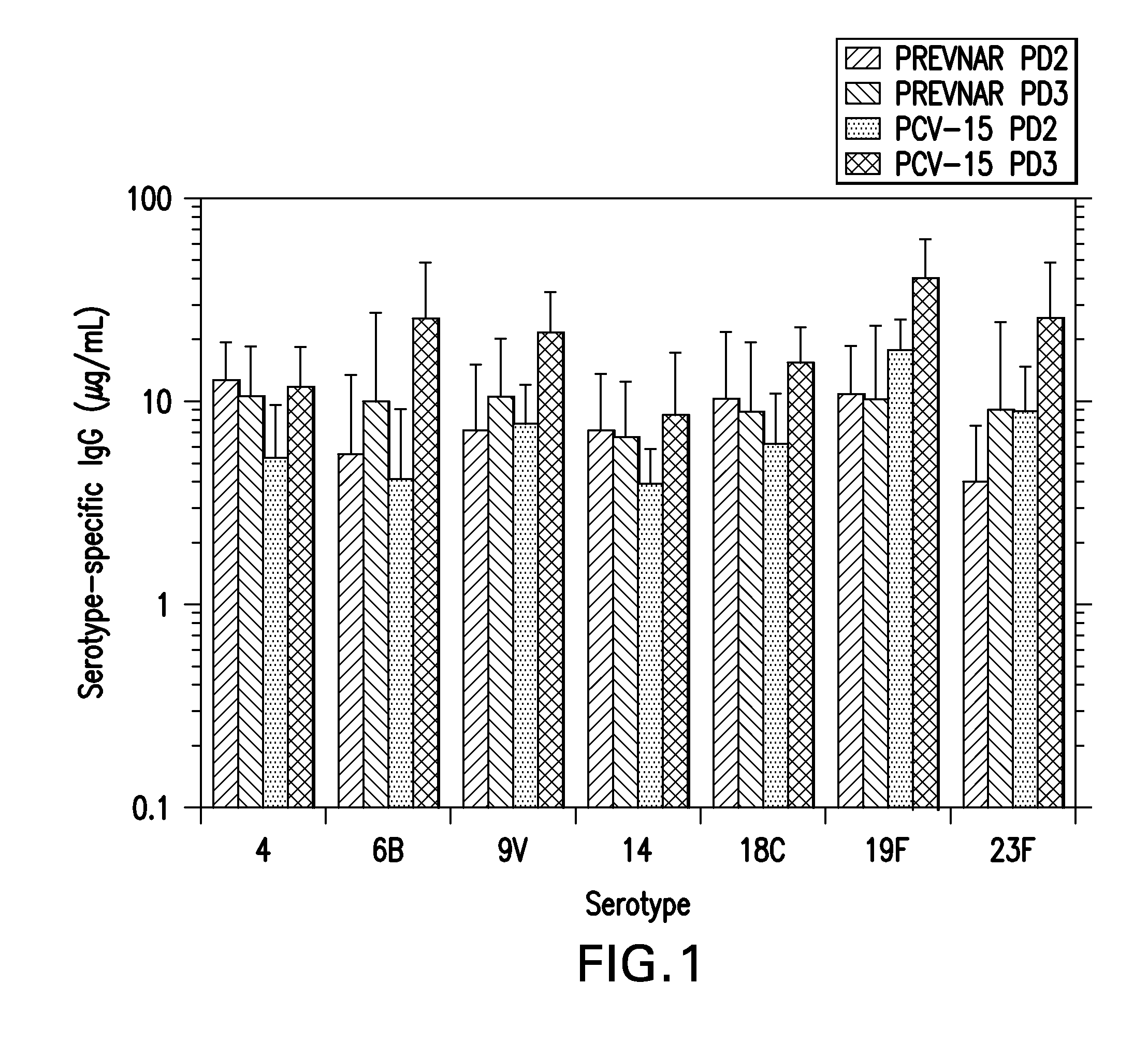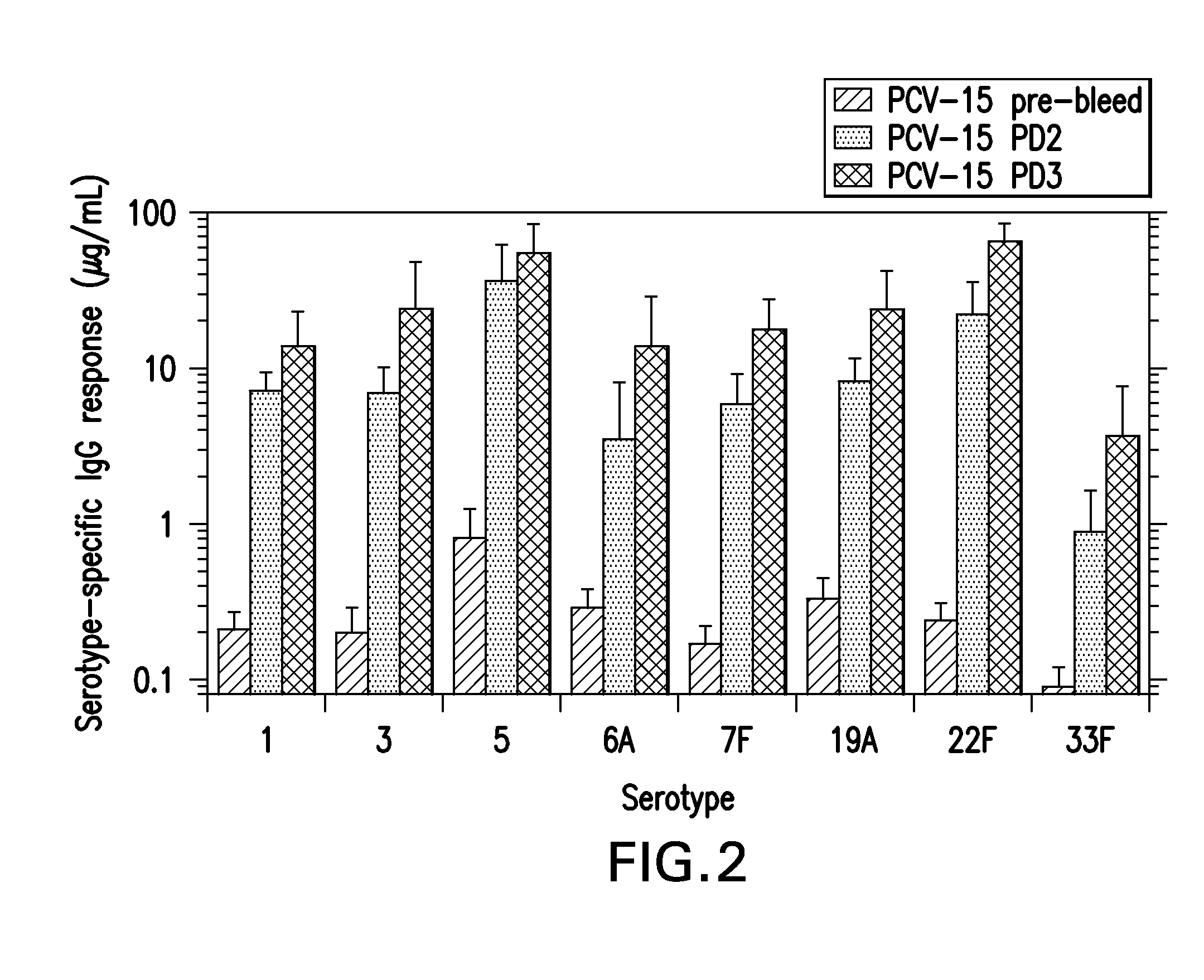15-valent pneumococcal polysaccharide-protein conjugate vaccine composition
a conjugate vaccine and polysaccharide technology, applied in the field of multivalent immunogenic compositions, can solve the problems of limited serotype coverage infants and young children can not respond well to unconjugated pneumococcal polysaccharide conjugate vaccines, and can be difficult to identify the serotype of prevnar® in certain regions of the world
- Summary
- Abstract
- Description
- Claims
- Application Information
AI Technical Summary
Benefits of technology
Problems solved by technology
Method used
Image
Examples
example 1
Preparation of S. Pneumoniae Capsular Polysaccharides
[0078]Methods of culturing pneumococci are well known in the art. See, e.g., Chase, 1967, Methods of Immunology and Immunochemistry 1:52. Methods of preparing pneumococcal capsular polysaccharides are also well known in the art. See, e.g., European Patent No. EPO497524. Isolates of pneumococcal subtypes are available from the ATCC.
[0079]The bacteria are identified as encapsulated, non-motile, Gram-positive, lancet-shaped diplococci that are alpha-hemolytic on blood-agar. Subtypes are differentiated on the basis of Quelling reaction using specific antisera. See, e.g., U.S. Pat. No. 5,847,112.
Cell Banks
[0080]Cell banks representing each of the S. pneumococcus serotypes present in PCV-15 were obtained from the Merck Culture Collection (Rahway, N.J.) in a frozen vial.
[0081]A thawed seed culture was transferred to the seed fermentor containing an appropriate pre-sterilized growth media.
Seed Fermentation
[0082]The culture was ...
example 2
Preparation of Pneumococcal Polysaccharide-CRM197 Conjugates
Activation Process
[0086]The different serotype saccharides are individually conjugated to the purified CRM197 carrier protein using a common process flow. In this process the saccharide is dissolved, sized to a target molecular mass, chemically activated and buffer-exchanged by ultrafiltration. The purified CRM197 is then conjugated with the activated saccharide and the resulting conjugate is purified by ultrafiltration prior to a final 0.2 μm membrane filtration. Several process parameters within each step, such as pH, temperature, concentration, and time are serotype-specific as described in this example.
[0087]Step 1: Dissolution
[0088]Purified polysaccharide was dissolved in water to a concentration of 2-3 mg / mL. The dissolved polysaccharide was passed through a mechanical homogenizer with pressure preset from 0-1000 bar. Following size reduction, the saccharide was concentrated and diafiltered with sterile water on a 10 ...
example 3
Formulation of a 15-Valent Pneumococcal Conjugate Vaccine
[0102]The required volumes of bulk concentrates were calculated based on the batch volume and the bulk saccharide concentrations. The combined 15 conjugates were further diluted to a target adsorption concentration by the addition of a sodium chloride and L-histidine, pH 5.8, containing buffer. After sufficient mixing, the blend was sterile filtered through a 0.2 μm membrane. The sterile formulated bulk was mixed gently during and following its blending with bulk aluminum phosphate. The formulated vaccine was stored at 2-8° C.
[0103]In an alternate process, the combined 15 conjugates were further diluted to a target concentration by the addition of a sodium chloride and L-histidine, pH 5.8, containing buffer. Polysorbate 80 was added to a final concentration of 0.005%, to the diluted buffered conjugate mixture prior to sterile filtration. Following sterile filtration, the formulated vaccine was stored at 2-8° C.
[0104]Table 1 sh...
PUM
| Property | Measurement | Unit |
|---|---|---|
| particle size | aaaaa | aaaaa |
| concentration | aaaaa | aaaaa |
| pressure | aaaaa | aaaaa |
Abstract
Description
Claims
Application Information
 Login to View More
Login to View More - R&D
- Intellectual Property
- Life Sciences
- Materials
- Tech Scout
- Unparalleled Data Quality
- Higher Quality Content
- 60% Fewer Hallucinations
Browse by: Latest US Patents, China's latest patents, Technical Efficacy Thesaurus, Application Domain, Technology Topic, Popular Technical Reports.
© 2025 PatSnap. All rights reserved.Legal|Privacy policy|Modern Slavery Act Transparency Statement|Sitemap|About US| Contact US: help@patsnap.com



